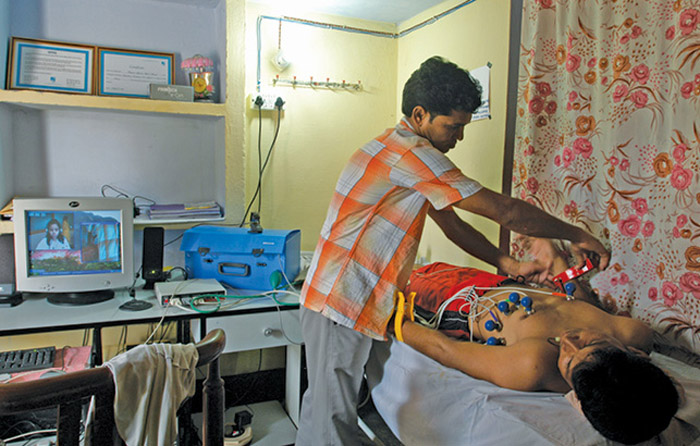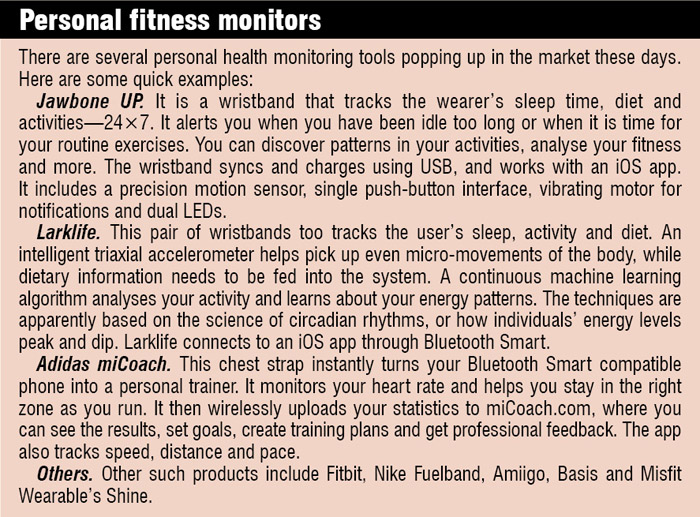“Availability of electricity is also a huge challenge in rural as well as semi-urban areas. Alternatives like solar are still too expensive, although the prices are coming down. Plus, operation, maintenance and support of the telemedicine infrastructure are always a problem in the absence of adequately trained personnel,” he adds.
These challenges reflect in the design and engineering goals of telemedicine and health monitoring equipment.
Design considerations and constraints
According to Kumar, when developing telemedicine solutions, engineers should keep in mind data accuracy, patient safety, low power consumption, ease of use and ruggedness. At the same time, these solutions have to be very powerful and accurate.
Software engineers also have to consider the rural environment when developing applications for remote healthcare. The software has to be light, capable of running on minimal resources. Considering the fact that it might be used by untrained professionals, the interface must be very simple. It must also support local languages.
ReMeDi telemedicine setup is used in the remotest rural areas for conducting different types of medical tests

Gupta adds, “While implementing ICT-based solutions, especially in rural areas of India, the designers will have to keep in mind that the infrastructure available is at the bare minimum. The solution should be capable of adapting to this infrastructural deficit and work its way around enabling the healthcare services on the lowest possible bandwidth with minimal resources. Thus, while solutions in the West might work on 5 MB, in India they need to work at 500 kB or lesser. Cisco’s HealthPresence 2.5, for instance, can work even at 300 kbps.”
He further says, “The second design consideration is the language support. Cisco’s solutions work around this using a special queuing technology that enables patients to find doctors who speak their language and have the right specialisation.”
“The third design consideration in emerging countries is that patients sometimes want an unscheduled visit; we could call it ad hoc consultations. Cisco caters to these using scheduling systems, and also by bringing in ‘presence’ within the application to enable paramedics to find any doctor who may be available,” Gupta stated.
In the race to overcome these constraints and come up with the best and most cost-efficient solution, the industry has absorbed several interesting technologies from the world of electronics and telecommunications. While some solutions are characterised by advanced technologies, others focus on understanding and catering to rural India.
Let us look at some of the telemedicine and health monitoring solutions being used in India, and what makes them successful.
High-tech in small packages
The extensive use of MEMS is one of the greatest developments in the field of telemedicine and health monitoring in the last few years.
“MEMS is the technology behind various types of silicon sensors and nano-pumps. STMicroelectronics provides consumer sensor technologies that include multiple-axis motion and orientation sensors, compass, pressure, temperature, sound (microphone) as well as biological and molecular compounds. These sensors can now be applied to monitor various aspects of the human anatomy and organ functions where accuracy and sensitivity are critical,” says Vivek Sharma, regional vice president, Greater China and South Asia Region-India Operations, and director-India Design Centres, STMicroelectronics. ST adds these capabilities to its low-power microcontroller and communication chip technologies, and offers several innovative healthcare products.
ST’s Body Gateway (BG), an integrated remote monitoring solution for advanced telemedicine platforms, is an interesting example. It is a lightweight and low-power electronic system for measurement and management of physiological parameters like electro-cardiogram (ECG), heart rate, breathing rate, weight, etc. A tiny module that can be taped to the patient’s chest, the BG collects data from a suite of sensors, performs initial processing, stores the data and prepares it for transmission over a network to the remote application server.
Another interesting solution is the eye pressure monitor to monitor Glaucoma. Developed by ST in collaboration with Sensimed, the solution is based on a smart contact lens that uses a tiny embedded strain gauge to monitor the curvature of the eye over an extended period of time, providing valuable disease management data that is not currently obtainable using conventional ophthalmic tests.
Switzerland-based Debiotech and ST have developed silicon-based microfluidic devices that deliver insulin using a miniature disposable insulin pump. Insulin pump therapy is emerging as an attractive alternative to individual insulin injections. The patient is connected to a programmable pump including a storage reservoir, from which insulin is infused into the tissue under the skin, day and night, according to the specific needs of the patient. The system uses miniature MEMS-based technology, and also supports remote administration.







